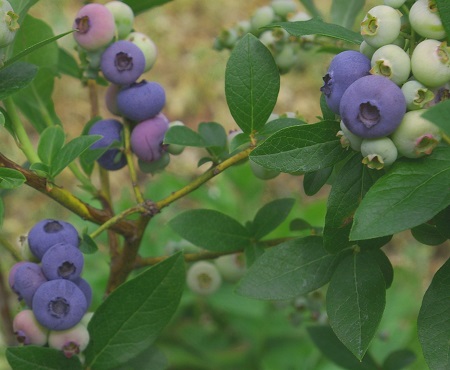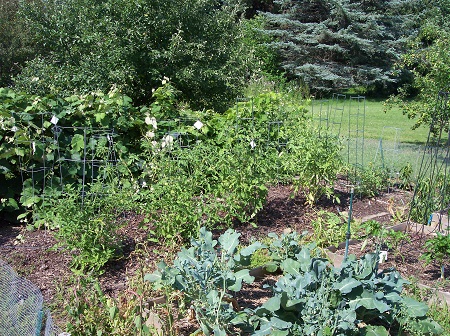
The Almanac Garden Planner - Use It Free for 7 Days!
Plan your 2025 garden with our award-winning Garden Planner.
ADVERTISEMENT
I mostly used a rototiller for my gardening... but it doesn't get as deep as double digging. A neighbor was asking me what I was doing, so I told him. While taking a break I looked up on the computer about double digging, and read about "The myth of double digging". That was the end of double digging for me. I finished double digging the bed I was working on.
I used 6 in sections of pressure treated (pt) 4x4. 2 sides had a 3/4 in deep slot slightly wider than 1/2 in. The other 2 sides had 3/8 in. deep by 1 and 1/2 in wide slot. I cut some 2x4 pt into slats, about 12 in. long, to fit in those wide slots on the 4x4. 4 blocks had the deep narrow slots on adjacent corners. the others were opposite.
in the wide cuts I put the slats, nailed and glued. Now all I had to do was drive them into place. A 6 foot piece of cedar board (used for fencing) would fit into the slots. Voila! A 6 in. deep raised bed with no tilling or digging.
I tried the newspaper method but will not do that again. Corn planted on the paper did not grow well at all. I have pictures to show but don't know if I can post them here.
I planted sugar snap peas between the rows of corn, all seeds went right to the soil. I also planted the rest of that bed with sugar snap peas, scattering and just pushing the seed into the mulch. This was not as good, as the bacteria that are decomposing the grass, can't tell the difference between a seed wanting to grow and mulch needing compost. If the roots of the peas didn't get to the soil in time, the seed rotted. if the roots got to the soil, the bacterial decomposing was stopped. Seeds will be planted directly on the soil from now on.
The double dug bed now has the cedar border. What occurred to me is, If I wanted to move my garden, all I have to do is pick up the pieces and put them down in another place. But I don't know why I would, its in the best place for a garden in the back yard.
Hope this helps and oh almost forgot the best part.
I planted squash in the double dug bed. Its not the double digging that is important... but that I drip watered each plant with its own 1-gallon milk jug.
I put a small (wire brad sized ) hole in the bottom, opposite the handle. This way I could pick it up to clean out the hole and put the hole where it needed to be, that is, close to the roots.
We had some serious heat waves as we usually do in NW Oregon. But my squash plants did not even notice it. They stayed upright like good plants should all through the heat. The jugs were very easy to fill with a garden hose.
I need a picture of this!
I was wondering if tomatoes flowered early when under stressed, and if so, approximately what dates should they start to flower? I live in zone five, north central Indiana.
If the tomato plants are stressed from heat or drought, the usual symptoms include wilting, yellowed leaves, blossom drop, and blossom end rot. They'd have difficulty producing. The solutions include watering--but consistent irrigation, mulching to keep plants cool, and even shade covers.
Growth depends on the sunlight levels and quantity, soil, weather conditions, and more. In general, it might take about 40 day from transplant to start of blooms.
Your article was copied here...
http://www.thegardenprepper.com/strategic-moves-tips-for-easier-gardening/
They've stolen my articles...let them know it's not ok.
Lisa, Thank you for letting us know that our writer's content was scraped without permission. What a shame. We have contacted them. Thank you, again. We appreciate your interest in The Old Farmer's Almanac and our Web site. Sincerely, the OFA editors
You have developed a great idea! But I also have a middle-aged gardener and harder to get work in the garden. I now have a problem because of the climate the soil has become very dry. My neighbor use to moisten the grains in the soil grain moisture tester, have you heard of it? What do you think, worth a try?
We use those Topsy-Turvy planters for our tomatoes and cucumbers. They are space-saving, plus you don't have to squat, kneel or bend to tend to them. But the best part - we seem to get a "bumper" crop because the plants get HUGE!
Another benefit of these planters - if the crazy New England weather turns bad they can be moved indoors if needed
send more info.
I'm a lifelong organic gardener that broke her back 8 years ago so I've made lots of adjustments to my routines. I made raised growing beds with recycled lumber and put up wire fencing between metal fence posts for trellising pole beans, cucumbers and gourds. I use my lawn grass clippings for mulch continuously throughout the summer to keep down weeds, hold in moisture. I bought tools with long handles, a stool to use in the garden and wide-row sow my seeds (Dick Raymond's technique). My garden is smaller but very productive; adaptive aids made it possible to continue gardening.



.jpg) The first week of May I spread a six-inch-thick layer of shredded leaves on each raised vegetable and berry bed and around the fruit trees. Last fall’s leaves had been shredded and piled near the garden to decay over the winter.
The first week of May I spread a six-inch-thick layer of shredded leaves on each raised vegetable and berry bed and around the fruit trees. Last fall’s leaves had been shredded and piled near the garden to decay over the winter.








